Elizabeth Harrin's Blog, page 20
October 9, 2023
5 Reasons to Backfill Roles
Why would you want to backfill a role? For one position I backfilled, we wanted a particular specialist role to come and work in a project delivery capacity for a year, so we had the right skills on the project team.
Backfilling means there is no gap in the team. You get an expert with the right skills to fill a vacant position temporarily.
Here are 5 reasons why you might want to backfill a position.
1. Short-term absenceFor a short-term absence, you wouldn’t normally look at backfilling a position unless it was critical that someone was available in the role. Does anyone backfill you while you’re on vacation? Probably not – although you might write a handover email to a colleague in case there are any questions while you are away.
However, some roles have to be filled during absence, especially customer-facing roles. Backfilling can avoid costly disruption. For example, in a hospital, you might bring in additional clinical staff during short-term absence so that clinics don’t have to be cancelled.
When someone is on jury service, military leave, paternity leave and so on there might be cause to find someone to fill the gap. Filling the gap is harder for managerial positions in this case (in my opinion) as to be a good manager you need to know the team, but it might be possible for an internal candidate to step up temporarily.
In this case, you might need to backfill the role by finding a temporary member of staff, contractor or agency worker who can step in to take on the workload of the absent employee.
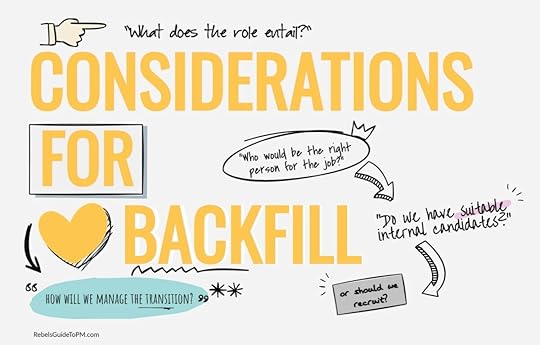 2. Long term absence
2. Long term absenceLong term absence could be caused by sickness or planned absence like maternity or shared parental leave.
You may or may not have notice that this is happening (yes for maternity, no for sickness) and you may be able to cope without the role being filled for a bit before the backfill need becomes urgent.
Filling a role like this will most likely go through the normal hiring process for your organization. You might have a range of potential candidates to interview and they’ll be with you for many months so it’s worth taking the time to write a good job description.
Ideally, you’ll have the time to work with the person leaving to carry out a handover. You can make contingency plans for what will happen when they are out of the business.
You might also find it helpful to use the opportunity to upskill another member of the team. Then they can move into a more senior role because they will have had several months of experience by the time the person comes back.
3. SecondmentAnother type of long term absence is someone being seconded to a project team.
For example, the project team needs a particular set of skills. A call goes out to the staff with those skills and someone is chosen (or “volunteered”) or interviewed for the role. However, their day job still needs to be done. Their move to the project team creates a gap in their ‘home’ team, and that gap needs to be backfilled.
A project secondment could be six to nine months or longer.
In my experience – and you might have felt this too – people who are given a project-related secondment don’t always want to go back to their ‘home’ team. They’ve learned a lot, taking on additional responsibilities, experienced the highs and lows of project delivery and going back to their day job feels like a backwards step.
Secondments can be great for employee morale and career progression, although that does give the ‘home’ manager a bit of a headache as they’ve got to find a suitable candidate to replace them!
If that’s the case, you might consider what permanent opportunities you could find for them that would make use of their new skills.
4. SabbaticalsA sabbatical is where someone leaves their role in the organization for a set period of time and their job is held open for them. In an academic setting, educators might go on sabbatical, which means they leave their teaching duties but spend time researching instead.
Sabbaticals are also benefits offered by some companies. I know a company that offers staff a 6-month break after a specific amount of service, and that’s a great perk. People use it for travelling.
I think this is the rarest reason why you’d want to backfill a role, but it’s a possibility that might come up in your career as a line manager.
Fortunately, sabbaticals are likely to be planned in conjunction with the employer, so you should have adequate notice for any recruitment necessary.
5. LeavingFinally, you might need to backfill a role because an employee has left. People leave for lots of reasons, so your staffing gap could be because:
They’ve quit to go and work somewhere elseYou’ve asked them to leave and their contract has been terminatedThey have chosen to retireThere has been an organizational restructure and they have been moved to another area of the business or their role has been transferred to a third party and they’ve gone with it (in the UK this is TUPE).In some of those cases you’ll have notice and the current employee should be able to provide some knowledge transfer and a handover.
For example, it’s normally pretty obvious when someone is retiring. I know past colleagues who have left the business to retire spent a lot of time talking about their plans – they weren’t shy about letting people know they were off!
Even in other cases, you might have some notice, so use that to get ready to fill the gap.
When someone leaves, you are likely to want to replace them with an equivalent full-time head. In this case, you’re backfilling the role but with a permanent hire – and that’s not really backfilling.
Backfilling in this situation would be to get a temp worker into the job quickly while you look for a permanent replacement.
If you’ve ever seen a colleague with ‘Acting’ in their job title then they are probably filling in while the empty post is being recruited for.
Get ready to backfill nowAll of these reasons require a proactive approach so you are ready to move and fill a role on a temporary basis whenever you need to. If you do get an inkling that someone is likely to be out for any length of time, have a plan for what you will do.
Cross-training colleagues now will help you have a pool of people in the team to draw from should the need arise, although obviously you’ll sometimes need specialist skills hired in through external recruitment.
Remember, the worst outcome is that you dump the workload of a key employee on someone else in the team and that leads to burnout and low morale. Backfilling is the solution to that: no on should be expected to do two people’s jobs.
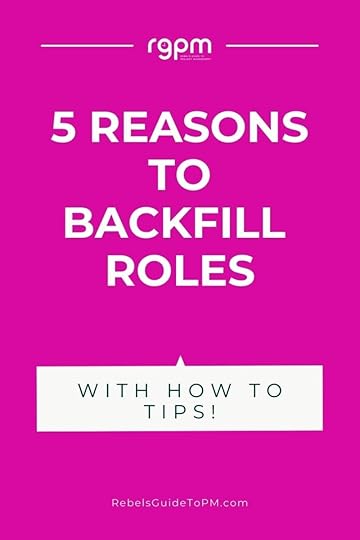
This article first appeared at Rebel's Guide to Project Management
October 7, 2023
Sauce & Spoon: Tips for Your Google Capstone course
I’ve been managing projects for over 20 years and I found the Google Project Management Certificate capstone course quite tricky. It’s hard to know what they are looking for in the Sauce & Spoon case study, so if you’re working through the course, here are some tips as you prepare to submit your capstone assignments.
For more general tips on how to earn the Google project management certificate quickly, read the story of how I passed the certificate in a week.
Recommended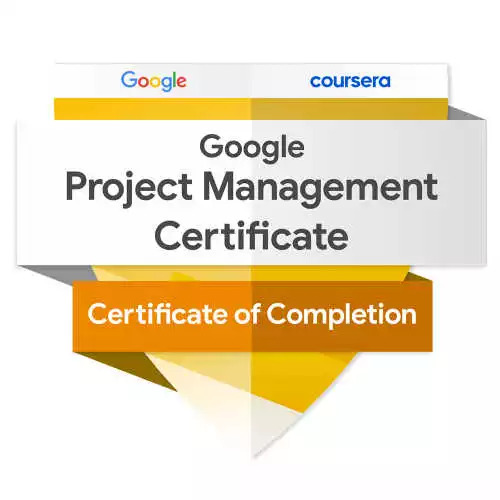 Google Project Management Certificate 5.0
Google Project Management Certificate 5.0 A solid, professional, well-recognized project management course from a great training provider. Perfect for beginners and people interested in learning more about project management as a career.
Learn more We earn a commission if you click this link and make a purchase, at no additional cost to you #ad Applying Project Management in the Real World capstone: overviewThe premise of the capstone is that you work through a realistic project scenario, responding to data as it unfolds. The assignment is peer-assessed and graded based on project documentation you submit.
Sauce & Spoon is a restaurant chain that wants to expand. They are launching new menus on the tablets on each table, with the goal of making it easier for guests to order and speeding up the time it takes to get the food out.
There are multiple stakeholders involved from the senior executives to the kitchen staff, front of hours and the IT team.
You’re acting in the project management role, guiding the project through the lifecycle to completion.
It’s not an agile project management case study but I can tell you that it’s realistic. I have never worked on a project where it’s been so easy to elicit requirements and to get information out of stakeholders, but apart from that, it’s realistic! I’ve reviewed the Google Project Management course overall, and generally the content is a good representation of your average, straightforward project.
Tip: Go back to your documentation for Office Green/Plant Pals and use those as inspiration for the Sauce & Spoon documentation as the templates are the same.
Sauce & Spoon project charterThe information you need for the summary and project goals is dotted throughout the case study material. The charter is the first document you create (as we’re in the project initiation phase), so there isn’t that much information to sift through.
I think it’s important that you do your own work and extract the deliverables, project scope, benefits and costs from the case study materials, but I will share my project summary and appendix. Don’t copy it (Coursera asks you to validate that it is your own work and if they find out you are a copyright thief, they’ll kick you out).
Project summary
This project aims to implement a guest-facing digital menu and point of sale system at two restaurant locations, North and Downtown by Q2. This will include a pilot in the bar area of a tablet system integrated into each table to allow guests to order from their tables and to improve the ticketing system into the kitchen. This will reduce the time it takes for customers to receive their orders.
AppendixI added a few bullet points to the appendix box.
Should we add a goal around decreasing guest wait time? The tablets will reduce table turn time but other factors might influence how busy the restaurant is.Resolved: We agreed to exclude this goal as the table turn time goal is more specific.
Should we reallocate some of the payroll? The tablets will allow servers to cover more tables and that would free up funding to increase the number of kitchen staff (line cooks, bussers and runners).Not yet resolved; next steps: Continue to discussOrder return policy: As a result of the data collected by the tablets, we will be able to evidence to customers what they ordered and this should reduce returns and comped food.
Resolved; agreement reached. This will be managed outside of the project and will be picked up by operations.Should we extend rollout to include all table sections, not just the bar? This has been requested by Omar.
Not yet resolved; next steps: Peta to organise a meeting.
I should add that I have never included an appendix like this in a real project charter. The content here would be included in my RAID decision log, or in an action log if they are not yet resolved.
Drafting influential emailsWho is to say what makes an email influential? The second Week 1 peer-reviewed activity is to create an email coalition for the Sauce & Spoon team, writing “influential emails” so you can sway decision-making.
This is hard to do without knowing the individuals, and while Peta the project manager (i.e. you) does have some background information on the personalities to work with, it’s not a lot. You should also have completed a stakeholder analysis document this week, so that helps too.
The task is made harder as there is no right or wrong answer: you have to draft your message in your own words. Remember to check the marking schema so you can hit all the points. Submit your emails in a Google Doc with the settings set to public so anyone can read it – otherwise you risk your peer reviewer not being able to give your project documents any marks at all.
Below, you can see my assignment as an example. I’ve blurred some of the text as encouragement for you to use your own words and not copy my work!
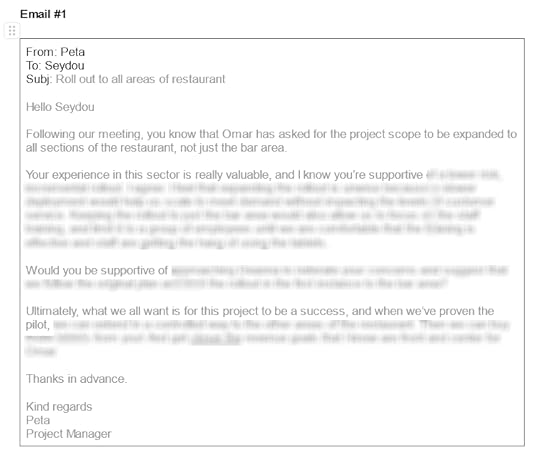 Sauce & Spoon project plan (Excel/Sheets)
Sauce & Spoon project plan (Excel/Sheets)Moving on to project planning.
The good thing about the whole Google project management certificate is that you aren’t expected to use any particular project management software. All the templates provided are either Google Docs/Google Sheets or Microsoft Word and Excel, so it’s very straightforward to complete the assignments with tools you already have.
Use the Sheets template to create the task list based on the tasks you’ve identified. Next, fill in the time estimates for project tasks. I saved time by not completing the Gantt chart boxes on the right, but in real life you would do that.
Save more time by not completing aspects you are not graded on, for example, the task owners. You can see in my assignment below that I did not complete that. Again, in real life you would. Equally, if you are using this assignment as evidence to recruiters that you can create a project plan, you’d be better off completing the whole thing to show them that you can!
You can see the task groupings and milestones I used in the image below.
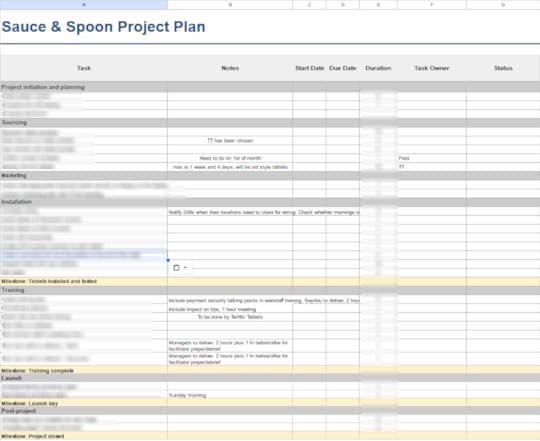
In Week 3 you will add quality standards, evaluation questions and survey questions to the plan and submit it again.
Evaluation findingsI enjoyed this assignment, which is about creating a short slide deck that summarizes the evaluation findings from the test launch event. I really do prefer PowerPoint for creating slides, but I used the Google Slides template because it was right there and it was easier to submit Google doc links.
Whether you go with PowerPoint or Google Slides, you’ll need these slides:
SummaryOverview of what was evaluated during the test launch (make a list of bullet points)Findings: Pick one element of the results to present as a graph. I chose to do the question: “Did the kitchen prepare your order correctly?”Next steps: Lead with the headline. I chose to focus in on the fact we only served the correct order in 72% of cases, which is a long way from the target. Summarize the next steps to tackle the problem in bullet point form.I added another Next Steps slide to summarize another major takeaway: only 56% of diners receive their order within 20 minutes. I described how the working groups would be set up to address this.
That’s it! You really don’t need loads of words on each slide.
Email to senior stakeholderIn Week 4 there are two peer-reviewed assignments to do. The first is writing an email to a senior stakeholder, Deanna.
I found the assignments where the answer was one thing or another (like a time estimate) easier to do than drafting narrative text. It is also harder to mark and more subjective, but do check the rubric for each assignment so you can see how you will be assessed.
You can see some of the email I drafted for the assignment below, as a starting point for your own work.
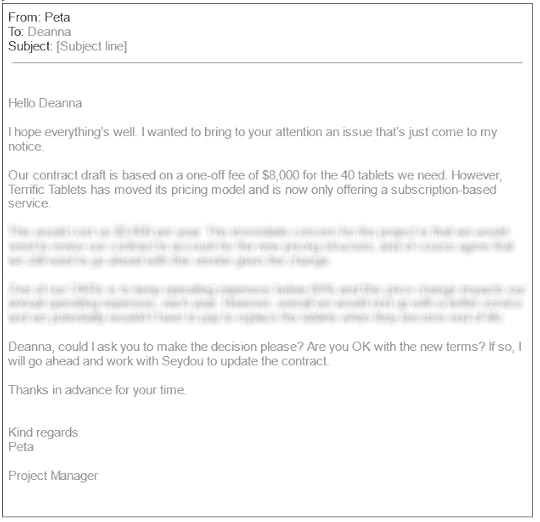 Close out report and exec summary
Close out report and exec summaryThe Sauce & Spoon close out report was quite time-consuming to do, but worth it as it provides the input to the exec summary for the project impact report.
You don’t have to write the whole impact report, just the executive summary, and that’s a good skill to get into the habit of.
Here’s how I completed my executive summary.
Vision: one sentence on the goals of the project.
Key results: I wrote one sentence on the increase in customer satisfaction, using specific numbers and data from the case study.
Revenue impact: I added a sentence on the revenue increase, using data from the case study.
Lessons learned: two sentences on lessons learned.
Next steps: The final sentence summarized the two main next steps.
Tips for submitting your workI kept a Word document with my study notes that included links to all my Google docs relevant to the capstone so I knew what I had submitted and could find my files again.
Make sure any Google docs submitted can be viewed by the public or people with the link, otherwise you’ll score zero as your peer reviewer won’t be able to see your work.
Make sure you submit the right file for the right assignment!
Don’t submit random files – I had a few to grade that were files not even relevant to the case study, such as someone’s CV. Zero points for that.
Don’t submit the link to the blank template! You’ll get a zero if there’s nothing in the file to mark.
Yes, you can search online for the answers to the assessed quizzes — the course has been around long enough now for people to have scraped the questions and answers — but you aren’t learning anything from that. Why cheat? That’s truly not going to help you get a job or keep a job.
Completing non-assessed workThere are other tasks to complete, and if you are new to project management I would encourage you to complete all the work. Build your confidence so you know what is expected of a project manager in a real job, and take your time to get familiar with the jargon, tools and documentation.
However, if you already have some project management experience and are not trying to build new skills, you can skip the other activities and only focus on the peer-reviewed content. That’s your risk though: sometimes there are nuggets of information relevant for assignments hidden in the other task descriptions and notes so you’ll potentially miss important information. Just like in real life if you skip over a few important emails!
However thorough this case study, it’s only that: a desk-based exercise. It’s helpful, relevant experience, but until you start talking to humans and working with stakeholders, your experience is going to remain theoretical.
Still, it’s going to give you something to talk about during your job search and I really rate the Google course as project management training for beginners.
Good luck with your capstone completion!
This article first appeared at Rebel's Guide to Project Management
October 3, 2023
3 Exam Content Outline Domains for the PMP exam
A Guide to the Project Management Body of Knowledge – (PMBOK® Guide) Seventh Edition represents a major shift in the way ‘how to do project management’ is presented by PMI.
Instead of the Knowledge Areas, we have the whole body of project management split up into performance domains. However, the annoying thing is that the project performance domains are not the same as the domains in the exam content outline.
If you are studying for the Project Management Professional (PMP)® exam, this is the article you need to help you break down and understand the contents of the exam.
In this article, we’ll explain what the performance domains are in the exam content outline and give you some examples of what you need to know about each one for the test.
What are the 3 performance domains you need for the PMP exam?PMI defines a domain like this in the exam content outline:
The high-level knowledge area that is essential to the practice of project management.
PMP Exam Content Outline, PMI, 2021
The 3 performance domains that are examined during the test are:
PeopleProcessBusiness Environment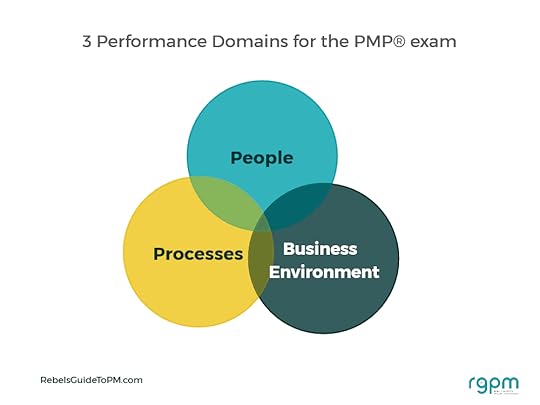
Within each domain, you’ll carry out a range of tasks as a project manager that fall into your responsibilities.
The big thing to note here is that these domains apply regardless of whether you are doing iterative, predictive, or hybrid projects, or any mishmash blend of them all. You still need to engage people, create effective processes and operate within your business environment: it’s all project management at the end of the day.
Let’s look at each of those domains next.
Domain I: PeopleThe People domain covers the soft(er) skills required to be a good project manager. These are:
Conflict managementTeam leadershipSupport team performance and developmentEmpower team members and stakeholders so they can contributeEnsure people are adequately trained to participate in the projectBuild a team that can deliver on the needs of the projectRemove roadblocks for the teamNegotiationCollaboration and engagement (also across virtual teams)Build a shared understandingCreate team ground rulesMentoringApply emotional intelligence.When you look at the list, it looks like a lot, but this domain shouldn’t worry you. It’s all the stuff you know to do anyway, because it’s part of what it means to operate in a leadership role in a modern organization, whether you are working on iterative, predictive or hybrid projects.
It’s worth noting that the APM Body of Knowledge also covers interpersonal and softer skills, and people like me have been writing books about how important the people stuff is to project management for years.
Competency models for project managers also call out these kinds of behaviors so we’ve known for a long time that they are part of what separates a good project manager from an excellent project manager.
Competency models are not the same as project management models: in the PMBOK Guide Seventh Edition, the term ‘models’ refers to commonly use strategies and approaches for optimizing the way work is done.
PMI has also acknowledged the importance of people skills, although I don’t recall them ever being called out so explicitly before.
Note for PMP exam takers: 42% of your exam questions will be from this domain.
The principles of project management from The Standard for Project Management will apply across the domains, so expect to study them all in an integrated way.
Recommended PMP study resourcesAll the training materials below will help you revise the material covered in each of the domains. (Scroll down for the next domain if you already have your PMP study materials sorted.)
Cost-effective training BrainBOK PMP Training $149.99Get BrainBOK's comprehensive suite of PMP® exam prep tools, including a full training program, ITTO pack, flashcards, practice exams and a formula guide.
 Buy Now Read my review We are pleased to be an affiliate of BrainBOK #ad Recommended The PMP PrepCast Elite PLUS $389
Buy Now Read my review We are pleased to be an affiliate of BrainBOK #ad Recommended The PMP PrepCast Elite PLUS $389 This complete self-directed PMP Exam course is our top pick. The Elite PLUS bundle includes the PMP training course, the PMP Exam Simulator, The Formula Guide, and The StudyCoach Guidebook, giving students a PMP Study Plan to follow.
Receive 20% off with discount code Sept23 during the month of September 2023!
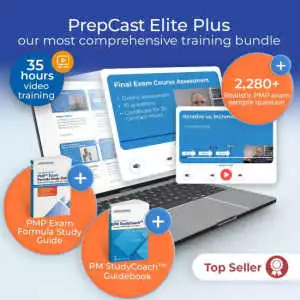 Buy Now Read Our Review We're pleased to be affiliates for The Project Management PrepCast #ad Recommended The PM PrepCast PMP Exam Simulator
Buy Now Read Our Review We're pleased to be affiliates for The Project Management PrepCast #ad Recommended The PM PrepCast PMP Exam Simulator Practicing before you take your PMP Exam is the best way to pass the test. This proven tool is brilliant at improving your confidence and highlighting areas where you need to build your skills -- includes detailed answers and references to what to study next.
Receive $20 off the PrepCast PMP Exam Simulator Deluxe with no discount needed during the month of September 2023!
 Learn more We earn a commission if you click and go on to make a purchase, at no cost to you #ad Interactive and engaging Brain Sensei PMP Exam Prep $499.99
Learn more We earn a commission if you click and go on to make a purchase, at no cost to you #ad Interactive and engaging Brain Sensei PMP Exam Prep $499.99 An interactive and engaging online, self-paced PMP exam prep course. Save 10% when you use our exclusive code RGPM10 at checkout.
 Buy now Read my review We earn a commission if you click this link and make a purchase, at no additional cost to you #ad Live Course PMP® Certification Exam Prep (Live Virtual Instructor) with Brain Sensei
Buy now Read my review We earn a commission if you click this link and make a purchase, at no additional cost to you #ad Live Course PMP® Certification Exam Prep (Live Virtual Instructor) with Brain Sensei An instructor-led virtual PMP Exam prep course for those who prefer a more interactive experience. Save 10% when you use our exclusive code RGPM10 at checkout.
 Buy Now We earn a commission if you click this link and make a purchase, at no additional cost to you #ad Online Courses by Insite - PMP Certification Exam Prep & Training - Velociteach
Buy Now We earn a commission if you click this link and make a purchase, at no additional cost to you #ad Online Courses by Insite - PMP Certification Exam Prep & Training - Velociteach
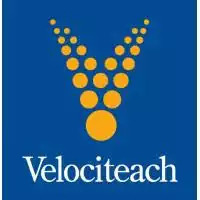 Buy Now We earn a commission if you click this link and make a purchase, at no additional cost to you #ad PMP Exam Prep PM StudyCoach Guidebook $49.00
Buy Now We earn a commission if you click this link and make a purchase, at no additional cost to you #ad PMP Exam Prep PM StudyCoach Guidebook $49.00 These guidebooks give you a week-by-week study plan to follow to help you in your quest toward your PMP certification. Earn your PMP in 4 or 12 weeks!
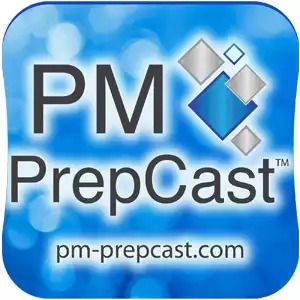 12 Week Plan 4 Week Plan We earn a commission if you click this link and make a purchase, at no additional cost to you #ad PMP Exam prep PMP Formulas Study Guide $29.00
12 Week Plan 4 Week Plan We earn a commission if you click this link and make a purchase, at no additional cost to you #ad PMP Exam prep PMP Formulas Study Guide $29.00 Want help studying the math and formulas on the PMP exam? This study guide will help you master them!
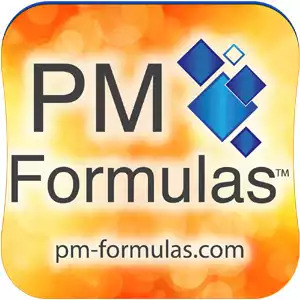 Learn more We earn a commission if you click this link and make a purchase, at no additional cost to you #ad Domain II: Process
Learn more We earn a commission if you click this link and make a purchase, at no additional cost to you #ad Domain II: ProcessThe Process domain covers the ‘technical’ skills of doing the work of being a project manager. These skills are:
Deliver business value through smart project executionCommunicationsRisk managementStakeholder analysisBudget and resource managementSchedule managementQuality managementScope managementProject integration (experienced readers may well have noticed that this list is starting to look a lot like the old list of Knowledge Areas from PMBOK 6)Project change managementProcurement managementConfiguration management (the management of assets and artifacts)Choosing the right methodology/approachGovernanceIssue managementKnowledge transfer and project closureIf you were familiar with the PMBOK Sixth Edition, a lot of the themes and sections here will seem at home. Many of the same topics from the old Knowledge Area segments are called out, and that’s to be expected: we need to be able to do them, and do them well.
This domain represents the technical expertise of a project manager and the expert knowledge that you bring to a team about how to use project processes to get work done.
Note for PMP exam takers: 50% of your exam questions will be from this domain.
So far, we’ve seen an almost 50/50 split between technical and interpersonal skills, but there is a third domain, and that’s the business environment.
Domain III: Business EnvironmentThe Business Environment domain covers how to operate within the context of your organization. You’ll see what I mean when you read the list of skills that are covered by this domain that are tested:
Compliance i.e. making sure the project meetings regulatory and compliance requirementsBenefits management (although you might not take responsibility for tracking benefits long term, the project should set up a way to track benefits)Review external influences on project scope i.e. being aware of what is happening in the wider business environment so you can adjust the project accordingly. In the past, project sponsors have taken this responsibility, so I see the role of the PM as to make sure sponsors are passing on information to us where we don’t have access to it.Support organizational change.This is only a short list but it’s very powerful. It’s everything to do with making a mark in the organization for the right reasons. It’s applying your business acumen. It’s realizing that there’s more to the organization than just your project and acting accordingly.
I think this domain is my favorite because I know from first-hand experience how much of a career difference it can make. It’s the difference between doing a reasonable job and being seen as a strategic influencer at work.
Note for PMP exam takers: 8% of your exam questions will be from this domain. Yes, that’s right! Only 8%! Don’t lose sleep over it.
The 3 domains make up the whole of the Exam Content Outline for the PMP exam.
As a project manager, you are expected to do a lot and be a lot. You can see that in this structure from PMI, in the competency framework from APM and in other career frameworks for project managers.
Yes, it’s a lot.
But it’s also a great role, with great salaries, huge variety and the ability to make a tangible difference to the world.
All senior management roles require a similar blend of interpersonal skills and technical expertise, and we are no different. It’s great to see this acknowledged in such a clear way.
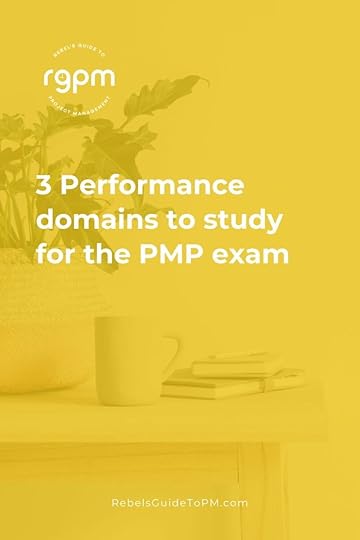
This article first appeared at Rebel's Guide to Project Management
October 1, 2023
How to list project management skills on your resume
When I brainstormed a list of project management skills to put on my resume (which over here in the UK we call a CV), it was a long list.
If you’re putting together an application for a job, you’ve probably found the same. How do you list the project management skills required without it turning into a giant list of buzzwords?
Here’s how.
How to include project management skills on your CVLet’s just go with the fact that CV and resume are interchangeable terms for the purposes of this article.
On my CV, I have a section that covers skills. While I try to make it obvious in the job descriptions and project descriptions, it’s worth calling out what you can do by adding a ‘Skills’ heading.
Mine is called ‘Skills Profile’. Underneath, I list skills grouped together by:
Interpersonal skillsLeadershipEach of those headings has a list of bullet points underneath that give examples of how I have demonstrated those skills.
I don’t specifically call out project management skills on my resume here: it’s implied in the list of projects I have led in the work experience section underneath.
However, if you don’t have work-related projects, you can add project management skills as one of those headings. That’s the bullet point where you’d talk about your ability to do the technical parts of project management.
What skills to choose?We aim for a CV to be a couple of pages. I’ve had to read resumes that were over 5 pages and frankly I lost the will to live. It’s too much, and too much detail. And there was a lot of jargon that meant nothing to me.
As you want to keep your application concise and to the point, you’ll need to be a little choosy about the project management skills that make it onto your resume.
The good news is that you don’t have to make that call yourself.
Use the job listing, job description, or personal profile to help you uncover what skills the hiring manager is looking for.
Many employers use sifting tools that look for keywords. They will program in keywords from the advert so those are definitely the ones to focus on.
Below, we’ll look at some examples of common project management skills for your resume.
Soft skills (a.k.a. Power skills)Soft skills are actually the hard part of project management! But we call them ‘soft’ because they are difficult to quantify and are more to do with interpersonal activities and emotional intelligence.
There’s now a trend towards calling them ‘power skills’ (started, I believe, by PMI) because calling them ‘soft’ makes them seem easy. And you don’t have to work as a project manager for very long before you realize they are truly not easy.
Power skills include:
Communication (written and verbal)ListeningStakeholder engagementConflict managementNegotiationInfluencingLeadershipTeam buildingChange management.Ethics, diversity and inclusion and managing workplace stress all fall into this category as well.
Hard skillsHard skills are technical project management skills: things you need to do to tick the box to prove you can lead a project. They aren’t necessarily ‘hard’ in the sense that they are difficult. They are ‘hard’ compared to ‘soft’, so if we’re moving to the power skills terminology, we should probably ditch hard skills as well.
On your resume, don’t describe them as ‘hard skills’, stick to terms like technical abilities, core competencies, technical skills, project management techniques or something similar.
This group of skills includes:
SchedulingTime managementResource managementProject budget managementScope managementGovernance and project assuranceRisk managementQuality managementProcurement, and supplier/contract managementIssue managementConfiguration management.Either list out the skills with an example that shows you can demonstrate each, or work these words and explanations into your job history section. As I said above, that’s what I do: the fact I can manage projects is woven all the way through my job history.
I don’t repeat that I do risk management for every project, and you don’t have to either. Think about showcasing one or two skills per job (or project) so overall your CV demonstrates that you can do them all. It would get boring to read about how you engaged stakeholders on every project — employers simply need to see a mention of it.
Tip: Check what project methodology your prospective employer uses. Then you can tailor your application to mention agile approaches, predictive or hybrid ways of working.
Describe your project management skillsIt’s not enough to simply give a list. Anyone can copy a list of skills from any website or job description. You also need to give an example of what that skill looks like, for you, based on your personal experience.
Here’s a real example of one of the bullet points from my CV that falls into the interpersonal skills section.
Excellent communication and presentation skills gained from speaking at conferences, delivering online and face-to-face training, and facilitating workshops in a professional setting.You can see that I name the skill and then describe how I demonstrate it. That gives an employer something to ask about at an interview: “Tell me about a time when you have had to facilitate a workshop.”
It also helps employers understand the scale and scope of your skills. For example, have you run workshops for 5 people or 500? There is no correct answer, but providing some numbers and context helps recruiters understand what you are capable of.
You don’t want to write too much, but you do want to let hiring managers know that you can actually do the skill, and haven’t just copied and pasted it off a list on the internet.
Your next stepsThe skills needed for project management jobs vary, so check out what is mentioned in the job posting and think hard about how you can evidence those. Then tailor your resume to highlight the skills that the employer feels are important.
Here are some things to do next.
Make sure you understand the project management job description so you can check you are listing the most appropriate skills.Brainstorm your past experience and consider how to include your work projects in your resume.Take a look at the different project management job titles so you know what jobs to apply for.Invest some time in updating your resume with project management skills and experience so your application shines.Good luck!
FAQWhat skills are needed for project management?Project management needs a mixture of technical and interpersonal skills including scheduling, team leadership, emotional intelligence, organizational ability, and communication.
This article first appeared at Rebel's Guide to Project Management
How to manage project assurance (with PRINCE2 guide)
You’ve probably heard project managers talk about project assurance, but what exactly is it? And how do you make it work to your advantage, without it taking up all your time or being very bureaucratic? (Because it sounds onerous and bureaucratic, right?)
I’ve worked on project teams for over 20 years and project assurance is just part of the job. It’s certainly nothing to be worried about – and it doesn’t have to be heavy.
Let me share some tips on what it is, who is responsible for project assurance, and how it works in real life.
What is project assurance?Project assurance is an ongoing check and balance to ensure that the project is being run right.
It’s what the project board does to reassure itself that the project team is operating as it should.
Project assurance is different to quality assurance. Quality assurance practices are to check that the project can create deliverables that are fit for purpose. Project assurance is much broader.
What does the project assurance role do?If you are asked to be the project assurance role, or to set up project assurance for your project, what does that actually mean you’ll be doing?
The project assurance role typically does 3 things.
1. Provide advice to the project managerThe assurance function will advise on who should be part of the project team. You might think that’s pretty obvious, but from a customer or supplier position, they might want to get one of their experts on to the team for very good reasons.
They might also advise the project manager on how best to do particular project management techniques like communication management, risk management, quality management and change management. They would help and advise around internal policies to ensure the project is compliant.
They can also help the project manager tailor the approach, methods or controls used to make sure it is fit for purpose. You should expect them to report back to the steering group to share any proposed changes to the standard methods for your organization!
The assurance role can be quite hands-on. For example, they can review product descriptions to check they are written appropriately, they can review risk responses to ensure they will adequately address the risks – and of course, provide feedback to the team so they can take appropriate action if something isn’t right.
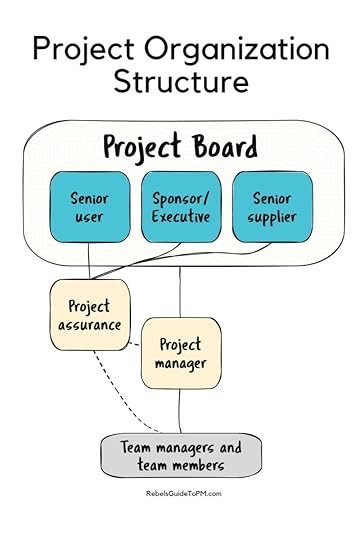 2. Provide independent confirmation to the project board
2. Provide independent confirmation to the project boardThe assurance function is the independent, confidence-boosting role that will confirm to the project board that the project is going to be compliant because the approaches selected to run it will work.
At each stage of the project, the assurance function will review the plan and targets, check tolerances have been set, review proposed quality activities, and make sure the proposed approach is realistic. They could use benchmarking from other projects, compliance to policies and procedures and lessons learned from other projects to inform their assessment.
They report back to the project board to provide that confidence level, or to flag up where the team is letting things slip.
The project board can also ask a relevant expert to provide assurance. For example, if an issue has happened and the board don’t really understand the recommendation report, they could ask the project assurance function to suggest an expert for them to talk to so they can make the right decisions.
3. Reassure the project board that project delivery is happening as it shouldOnce the project is running, the assurance function continues to check in and make sure the project is running in the right way, compliant with any policies and processes. If it isn’t, they could suggest corrective actions or propose that a detailed project audit is carried out to dig deeper.
If the project can no longer meet its goals, the function could even recommend that the project is closed.
The project manager will be reporting to the board, and hopefully what the project manager says and what the assurance function says will be the same!
Who is responsible for project assurance?Basically, project assurance is an advisory role that provides independent support and scrutiny.
The short answer is that everyone on the project team is responsible for assuring their work.
In PRINCE2 environments, it is specifically called out that project board members are accountable for assuring their particular areas. In PRINCE2, the project board is made up of a senior business rep (project executive or sponsor), a senior user and a supplier, whether that is an internal or external supplier.
The project sponsor provides business assurance i.e. that the project is performing to meet the business needs.
The senior user provides user assurance i.e. that the project is meeting the user’s requirements.
The senior supplier provides supplier assurance i.e. carrying out any checks to reassure the vendor that the project is going to be successful.
The project board is also responsible for:
Establishing how assurance will be doneEnsuring people doing assurance-related tasks know what their roles and responsibilities areDetermining how people with assurance responsibilities will work together.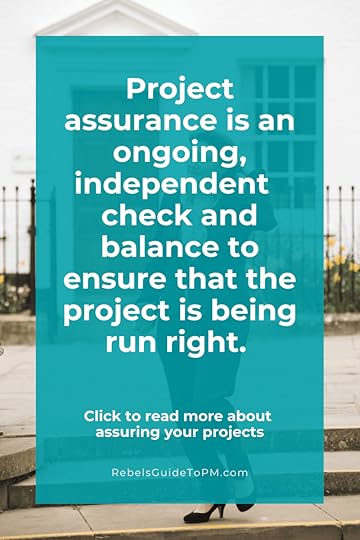
This situation could the project board end up marking their own homework, because they could do the assurance work themselves. I think it’s best if they delegate because we know from experience that senior managers rarely have the time to do extra tasks themselves, and they will probably be done more thoroughly if a subject matter expert is asked to do them.
The PRINCE2 manual says that project assurance roles cannot be assigned to the project manager, the project team members or the project support function – that is precisely to stop individuals in those roles marking their own homework. Assurance should be as independent as possible so stakeholders can have confidence in the project status the team is reporting.
In my experience, assurance is carried out by the PMO or another project manager whom I have invited to do a peer review.
When does assurance happen?In my experience, assurance happens during project board meetings. Project reports can be reviewed as a group, and the project manager (that’s you and me) get challenged about performance.
To be honest, most of my projects have had pretty reasonable and friendly steering groups. One or two of them have had project boards where the members take it on themselves to make sure they are getting an objective assessment of progress and really challenge to make sure we’re doing things right.
They are allowed to do that: the executive’s role is to make sure they get what they want from the project and they need to be able to trust that the project manager is capable and telling the truth.
Assurance can also happen at other times, for example, when moving from one project lifecycle stage to another (like during a gate review) or when the project plan is significantly changed.
Do you need an assurance committee?
For big projects and programs, you might find it useful to have a risk and assurance committee, or some kind of separate PMO-led project assurance function.
In my 20+ years of leading projects, I have only come across this once. It was a helpful ‘check and challenge’ to the way the project was being run and kept us focused on making progress. It provides ‘delivery confidence’ in a way that me saying, “Yes, everything is fine,” doesn’t!
I would suggest that you don’t need a separate assurance committee for the average small-to-medium sized project.
When the end of the project rolls round, the board might call on the assurance function to provide some final checks to make sure that everything that should be done has been done. For example, during the project closure stage they might ask for a peer review, or for someone from the PMO to review the closure report to check that it covers all the key points.
In summary…Project assurance is crucial to provide governance and credibility to your project. There are a lot of ways it can be done, but the key thing is that it’s independent from the project manager and team so the project board get an independent assessment of how the work is progressing and whether it is being managed appropriately.

This article first appeared at Rebel's Guide to Project Management
A practical guide to quality management, assurance & control
One of the questions I’m asked often when I’m mentoring project managers, is what is the difference between quality assurance and quality management?
To be honest, that’s the wrong question to be asking.
Quality management is the overarching approach, concept, principle, technique – whatever you want to call it. It is made up of three elements:
Quality planningQuality controlQuality assurance.Quality management is the term given to the techniques and standards used by the relevant people to achieve a quality result on the project – in other words, how you are going to make sure you end up delivering something good (or at least acceptable).
You can see that we can’t really compare quality management and quality assurance as one (assurance) is part of the other.
However, I know you still want to know the practical differences and similarities to make the terms stick in your head, so let me give you some more info on each of these, along with some examples from my project management experience.
Let’s start with quality planning, because that’s where we start on a real project: planning how we are going to get a quality result. I’ll also link the practice back to the PMBOK® Guide and Managing Successful Projects, the latest PRINCE2 manual.
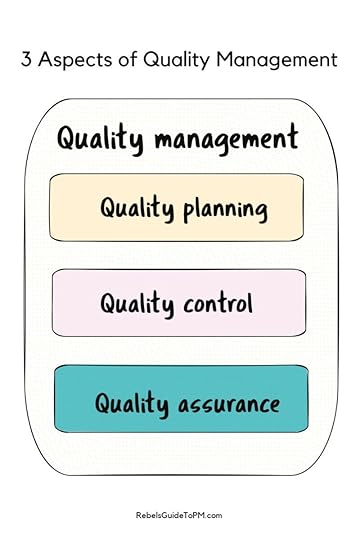 Quality planning
Quality planningQuality planning is the work you do at the start of the project (or throughout, if you are introducing a new deliverable later as part of a change, for example).
One of the project management principles in The Standard for Project Management is to build quality into processes and deliverables. So while we plan for it, the goal is to make it part of everything we do, built into the work as we go.
The activities include:
Identifying the deliverables (which PRINCE2 calls products) and documenting expectations around customer satisfaction about what quality standards they will adhere to.Identifying and documenting quality requirements, specifications and acceptance criteria and how these will be checked e.g. metrics, product verification and validation, audits, testing.Coming up with the quality management approach to ensure the project team can meet the expectations, specification and criteria set.Identifying who will ensure quality responsibilities are met.Setting a quality baseline with the project board’s approval.While you are finding out about customer requirements and documenting all the things you are going to do to ensure a good result, you’ll also be documenting the tolerances for each deliverable. You’ll also find out about any legislation or regulation that the project must comply with during this step.
What all this means is that you work out what a good quality project result looks like, and then plan how you are going to get there and who is going to do the work.
Quality planning exampleI’ll be honest: most of my projects don’t have pages of detailed written down requirements. We don’t have the discipline of creating product descriptions or detailed specs. However, we do set acceptance criteria, even if these are only documented in the project charter or a high-level business request document.
The quality baseline represents the expectation of the result you’ll get at the end of the project, but that might change. For example, let’s say you are creating a landscaped garden for your client. The client asks for 50 species of plant in the garden and together you make a list, with a tolerance of +/- five species. That’s a quality expectation.
The quality responsibilities are set as follows:
Producer: This is the person responsible for the deliverable/product/work package. In this case, that’s you, the project manager.
Reviewer: This is the person responsible for checking the product meets its quality criteria. In this case, that’s the client’s head gardener.
Acceptance authority: This is the person (or group) responsible for final sign off of the deliverable. In this case, that’s the client.
However, in our garden project it turns out that you can’t deliver 50 species because certain species are too expensive/too invasive/don’t grow in the soil that your client has. So you change the spec and plan to deliver 40 species instead. This is below the tolerance level so requires a formal change.
The change also creates a change to the quality baseline (assuming the project board approves the change) because you can’t deliver the result the client wanted. There is no corrective technique to apply here: you can’t change the process to deliver a different result. You either have the plants or you don’t.
In a software project, you can do product testing, perhaps review the process design and operational techniques and tweak what you are doing to get a different result. For some projects, preventative action is possible, but you might not have that possibility on every project.
Quality controlThe next aspect of quality management is control. Quality control is the work you do throughout the project to make sure that the products created are to the required specification. It’s the process of monitoring and checking quality.
PRINCE2 defines it like this (take a breath before you read this long sentence):
The procedures to monitor the specific products of a project and their development or delivery activities to determine whether they comply with relevant standards and of identifying ways to minimize causes of unsatisfactory performance.
Managing Successful Projects: PRINCE2 7th edition
The activities include:
Doing the quality checking tasks (i.e. implementing whatever quality management approach you planned for).Being aware of and acting on situations where the quality of products is not up to standard, including continuous improvement.Getting approval for the deliverables created.Quality control will help you spot defective products. If you think of software testing, the testing team is there to stop bugs making it into the final version. They spot quality issues before they reach the client so they can be resolved.
Quality control exampleIn our garden example, once the rockery is complete, the project manager would ask the client to sign off the finished product. The client compares what was delivered to the specification provided and approves the deliverable. In practice, the project manager will already have done that comparison and checked out that what they have delivered meets the spec.
We also installed a fountain, and there is a requirement to meet the appropriate standards for water quality. To check that, we hire an expert. Their quality control process involves checking the water every day for a month. The lab analyses the water and signs off that the fountain is compliant with standards. They provide certification as evidence.
Luckily for us, we already documented that we would need a testing lab to certify this deliverable as we figured that out during the planning stage. We planned for the lab costs in our project budget.
If the water didn’t meet satisfactory minimum requirements, we would take corrective action.
 Quality assurance
Quality assuranceQuality assurance the process of checking that the plans and approach are fit for purpose. Think of it as a confidence-boosting exercise for people who are not close to the delivery work but need reassurance that it is going to plan.
The activities include basically just that:
Ensuring that the planning and control approaches are robust enough to deliver the expected results.PRINCE2 defines effective quality assurance like this:
A planned and systematic activity that provides confidence that products will meet their defined quality specifications when tested under quality control.
Managing Successful Projects: PRINCE2 7th edition
In other words, it’s the process of making sure defects can’t happen (or are unlikely to happen) because you’ve done a good job of planning, building, checking in the first place.
Assurance is usually carried out by someone who is not in the project team. It’s an independent function as it seeks to check we’re doing the right thing. Often the function is provided by the PMO or another business team.
Quality assurance exampleI’ve never had anyone say to me that my project management plans would not end up delivering a result that meets the quality criteria. Quality assurance is one part of project assurance, and it’s all about checking that things are done right.
In our garden example, you could imagine that another project manager from our company reviews our plans and comments that if we put the pond where we’ve planned, it would flood the walled vegetable garden every winter, and that wouldn’t be the right thing to do.
“Aha!” we say. And we move the pond.
Later, that other project manager visits again and checks we really have moved the pond.
Quality assurance vs project assuranceProject assurance is a much wider subject than simply quality assurance, so don’t confuse the two.
Quality assurance is all about making sure the project deliverables are a good enough standard and that the team follows all the good practice and plans they laid out. It should be done by someone independent from the project who can hold them to account and keep them honest.
Project assurance checks that the whole project is being done in the right way. Their role in quality assurance is to:
Advise the project manager on anything to do with quality e.g. based on past projects or best practiceCheck that the approaches and control mechanisms proposed are actually going to deliver the results expected, and provide that level of confidence to the project boardCheck in regularly to ensure that what the project team said they would do, they are actually doing.Differences between quality assurance and quality controlThe assurance function holds the team accountable if they do not deliver.
It’s common to get quality assurance and quality control confused.
Quality control is about checking products are fit for purpose during the making of the product. This is where you find the defects and fix them.
Quality assurance aims to prevent the defects from happening in the first place by creating a culture of quality. The differences are below in tabular form.
AspectQuality Assurance (QA)Quality Control (QC)FocusPreventiveCorrectiveGoalAssures processes are followed correctlyIdentifying defects in the final product and ensuring the product meets requirementsWhen OccursThroughout the project lifecycleAfter the product is developedResponsibilityEveryone in the team is involvedSpecific team or individualsActivitiesProcess-oriented, process improvementProduct-oriented, error detectionToolsProcess checklists, audits, reviewsInspection, testing, samplingOutcomeCompliance with standards and proceduresDefect detection and correctionPrevents DefectsYesNo (but helps identify and fix them)How to document your quality management approach/planPRINCE2 talks about writing the quality management approach in the project initiation document. The PMBOK® Guide talks about creating a quality management plan that is part of the overall project or program management plan.
Either way, if you have internal quality standards, you can reference them or link to the intranet page where readers can find out more. Don’t make the document longer than you have to by repeating yourself.
If you don’t have anything you can reference to save yourself a job, here’s what to include.
Scope: Describe what work is covered by the scope of the quality management approach. It’s probably easier to describe what is excluded, as pretty much everything is likely to be covered. Who doesn’t want their project result to be a reasonable quality?
Procedures: Describe the process for control e.g. “Product quality will be reviewed internally by the project team before being reviewed by the client’s team and signed off by the project sponsor on confirmation that they meet the specification.” Document what change control process you’ll use as well (probably the standard project change control process).
Resources and responsibilities: List out who does what (a RACI matrix is good for this) and any non-human resources required.
Tools and techniques: List out how you are going to check quality e.g. what testing methods or statistical techniques will be used, what product sampling sizes you will use etc. Split out quality assurance and quality control techniques.
Standards: Document any overarching quality standards and protocols the project has to stick to. You can also put PMO standards in here, like references to the templates you will use to create a log of deliverables (the quality register in PRINCE2). Link to any standard operating procedures.
Finish off with a list of any further reading or references like any internal policy documents or a note about the quality management system software that will be used if you have any.
Project quality management in the PMBOK® GuidePMBOK 7 actually has very little in it that mandates how to approach quality. However, Process Groups: A Practice Guide does have all the info in about how to ‘do’ quality management. There are 3 processes:
Plan quality management: this is the process of creating the quality plan described above
Manage quality: this process is about assurance and process improvements
Control quality: this process is about recording the results of activities like testing to ensure the outputs are fit for purpose and meet customer expectations.
The quality balanceThe unfortunate fact is that quality costs money. Doing more testing, checking, auditing, validation, having people trained to a higher standard… it all costs money.
There’s a balance for the project team and key stakeholders to strike between spending loads of money on quality and getting a ‘good enough’ outcome.
Next stepsIf you’ve got this far, you’re probably planning how you are going to ‘do’ quality on your project. Here are some practical next steps to get going:
Talk to stakeholders about their expectations of quality.Check the business case or any other initiation documentation to see what quality criteria have already been mentioned.Talk about tolerances: are there any that are acceptable? Often there are not, or they aren’t easy to negotiate.Document what you find and then work out how you are going to achieve that. Cross-reference the plan and make sure there are tasks that allow you to deliver on those requirements – check you have a way to build them in and test them.
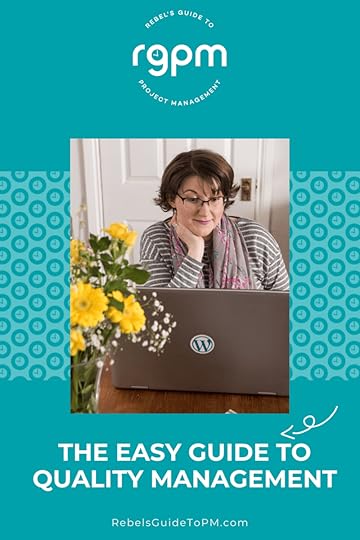
This article first appeared at Rebel's Guide to Project Management
September 29, 2023
How to handover a project on closure
You’ve delivered a great project – or at least made it to the end, exhausted! Now it’s time to handover the work because the project is closing.
But what do you have to do? If you’ve ever ended up on a project where the work never seems to end… and the changes keep coming in… and even though it is technically closed people still come to you for help… then this is for you!
I had one memorable project where I couldn’t get rid of it. There wasn’t anyone really to hand it over to, so a lot of the support questions came to me simply because I knew the work inside out. It was fine, but it did pull me away from other projects.
And it’s not what project management is supposed to be. We’re supposed to deliver the project, hand it over to a willing and welcoming BAU team and then move on to deliver the next cool thing.
Here’s how to make that happen so you can move on to your next project knowing you’ve left this one behind all tidy.
Handover vs project closureWhat is the difference between project handover and project closure?
Closure is the phase or stage of the project. It’s part of the project lifecycle. A closure document is a formal sign off that marks the end of the project work. It is a record of the project management process. The closure document talks about what you did and how that compared to what you set out to do.
Handover is part of the work the project manager has to do on the project to complete the closure. It happens when the deliverables are complete but it also includes providing information about the background and context for the project to provide a complete picture of the work that was done.
Handing something over is not a one-and-done activity. It’s a process that you’ll complete over time. We do it as it creates a smooth transition from the project environment to the operational/live/BAU environment.
When to do the handoverI’ve handed over many projects in my time, and my trick (it’s not really a trick) is to do an incremental handover.
Ideally, you should be handing over deliverables as they get completed. Don’t wait until the end of the project and handover a huge bunch of stuff. It’s overwhelming to the operational team and it’s too hard for them to stay on top of what is coming their way.
Choosing to involve the operational team on an ongoing basis only has advantages. The project handover process takes longer, yes, but the results are better because they are onboard with the idea and you aren’t throwing something over the fence to them (that’s how we used to talk about it when I worked in IT) and hoping they’ll catch it.
It’s not only deliverables that get handed over. You are also handing over the content and context, and knowledge.
Incremental knowledge transfer is a better approach. As soon as something is built or delivered, check where it should go and make sure they are ready to learn about it.
Of course, some things need to wait until the end of the project before they can be handed over, but try to spot anything that can be transferred earlier to save everyone additional headaches at project close.
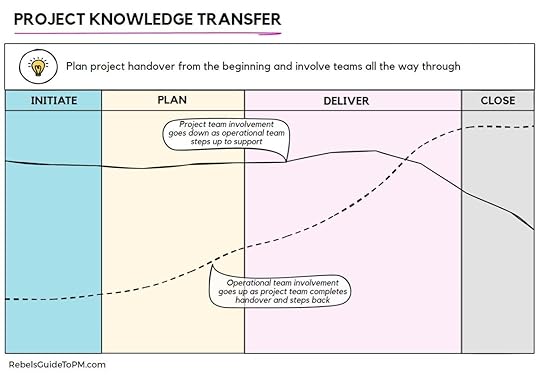 Step 1: Work out who gets the handover
Step 1: Work out who gets the handoverWho are you handing this project over to?
Ideally, you should know this already. It’s probably the project owner and their team. However, it’s possible that some of that group don’t have even a high-level overview of the project, so it’s worth planning in a recap.
You should plan for your handover from the beginning of the project. During project initiation you would have worked out the owners for each of the deliverables or at least the general team who will be receiving the handover.
Check your project RACI matrix as well or ask team leaders, subject matter experts and the project board to identify people – especially if the individuals who were there at the beginning have moved on. The communication plan may also have useful info in as there will be names of stakeholders in there.
If your project involved any changes to technology, make sure the handover includes the IT Help Desk or support desk or whatever you call them. They will be crucial in fielding incoming calls from users to the correct team.
Read next: 5 Tips for working with the IT helpdesk on projects.
Step 2: Work out what to handoverWhat, exactly, are you handing over?
Again, you should have this information already. During project initiation and planning you would have worked out what deliverables would be required. Check back to the project requirements and success criteria to see the complete list of what the operational team are expecting (remembering that change requests might have been made since that document was last updated).
Think about what the recipient of the handover needs to know. I start a handover document towards the end of a project or phase and use it to make notes of what information to pass on. The document becomes the basis for my knowledge transfer.
Use the project handover templates from your PMO or make your own. Generally, you’re looking for a checklist of things to cover off as you hand work over to your colleagues.
Start your notes with a handover plan templateI have a tried-and-tested Word document that I use as a handover and transition plan. It’s a great starting point for your own plans as it is fully customizable.
See the templateMembers of Project Management Rebels have access to this for free, along with a detailed handover checklist and lots of other resources.
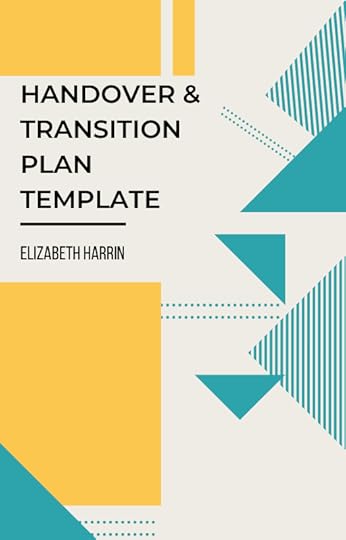
Here are the main things you should include in the handover.
General project status and backgroundWhat happened on the project? Share some information to provide the context for the project. What was the business reason for doing it and is that still valid? How far have you got with addressing the problem this project set out to fix?
Provide links to any project documentation for background. Share a bit of history: what worked well and what didn’t? If you’ve already had a lessons learned session, share the output from that.
If there are any risks that might still be relevant after the project has closed, pass those on too.
Scope items/deliverablesBe clear about what was created and completed and what was not. If there are any further project scope changes that you noted as a good idea but didn’t implement, hand those over too. Then the BAU team can choose whether to act on those changes and implement them in the future.
Scope can include system descriptions, design documents, process maps and other documentation as well as the software or systems themselves.
Schedule of remaining activityShare the outstanding project-related steps so the team know what is coming up and when they will be expected to run with the deliverables in a business as usual environment.
It’s likely that you’ll only have the project closure document to issue, but if you are doing incremental knowledge transfer or your deliverables are phased, there might be more of the project left to do.
BudgetShare the project budget position. How much was spent and on what? If any ‘spare’ budget is available, make sure the team know whether they can access it or whether it goes back into the main project pot.
Knowledge created during the projectShare any process maps, user guides or manuals, documents, the project wiki if you had one, videos, research papers and other things that might not strictly count as ‘proper’ deliverables but were created during the project.
Project artifacts like these are all very helpful when you want to make sure the handoveree gets a fully rounded picture and all the information they need to continue to carry out their role in the future using the project’s outputs.
Contact detailsI know you are moving on, but there are probably other contact details worth sharing. For example:
Procurement contacts who worked on the dealLegal contacts who supported with contract review approvalSupplier contacts who will maintain the products going forwardOther subject matter experts who supported the project.If the project backfilled any roles, let the BAU team know that those individuals will be moving back to their day jobs and the roles will no longer be filled – if that is the case.
ContractsThe number of times we’ve had to look for contracts and it’s taken ages because they aren’t stored anywhere central…
If you have a central contract repository, or a procurement/purchasing team that is responsible for contract management, make sure they have a copy of any final, signed contracts.
If you have version-controlled documents (and contracts should be), make sure the latest versions are what you handover.
Part of the project work will be to close out contracts, but any ongoing contracts, for example, maintenance and support provision, will need to be actively managed by someone.
Systems informationMake a list of any system logins and software that has been set up, installed or improved as part of the project. Check the right people have the logins and permissions they need. In particular, make sure someone who is not you has admin rights to add and remove new users as new employees join the team.
Benefits trackingFinally, the project was most likely delivered because the organization wants to achieve some kind of business outcome from it. Who is going to be tracking project benefits and how are they going to do it?
On one of my programs, we have projects that are completed and projects that are still in-flight. The project BAU owners for the completed projects track benefits and present those numbers back to the program board.
Identify who is responsible for ongoing tracking, what they have to track, how that is reported back (and who to) and how long they have to track for.
Perhaps they won’t have to report back to anyone and the data is only for their information. But make sure you both know what is expected.
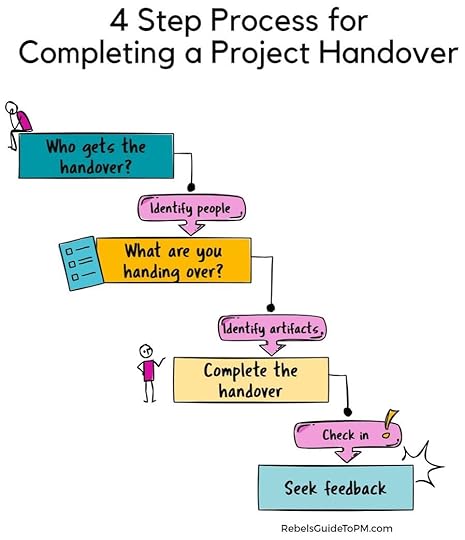 Step 3: Do the handover
Step 3: Do the handoverThe next step is to complete the handover.
Handovers are literally just meetings where you talk to the person about the thing you are handing over to them. They can ask questions. In my experience, they often forget some questions and follow up with you later – that’s fine too.
Schedule any one-to-one or joint meetings for knowledge sharing sessions. You can also provide a written handover in the form of your notes, links to documents or Microsoft Teams channels etc.
You might see people recommending that you complete a handoff document, but in my experience, the kinds of projects I work on end up with multiple documents because there is more to handover than can be written down in one document. For example, we also handover systems access.
Step 4: Ask for feedback and be around to supportFinally, check in with the handoveree and see if there is anything else you can provide them with.
Hopefully they will say no, but offering is good practice. It should reduce the amount of questions you get later when technically you should be working on another project.
You may also want to run a ‘hypercare’ phase where you are jointly responsible for support. Work together to manage incoming queries and manage the deliverables until the BAU team feel comfortable doing it by themselves.
Hypercare is particularly relevant if one of your deliverables is software. Typically we use it when there is a product launch and a team has to use a new software tool. The project team provide on-site support while the users get up to speed with how it works. You can extend this concept into the handover phase too, if it is useful.
Your next stepsIf you have read this far, you probably have a project close coming up. Here are some simple action steps to prepare for your project handover phase.
Collate all documentation that needs to be handed overReview the RACI and identify who receives what during the handoverStart a set of project handover notes so you don’t forget anythingSchedule some handover meetings with key stakeholders.And that’s it! Walking away from a project can bring up all kinds of feelings, especially if the project went really well and you worked with an excellent team.
Read my complete guide to project closure for what else to consider during this phase of your work. I also have a specific guide for project closure in PRINCE2 if you use that method. Remember that whatever the outcome of your project, you did your best!
This article first appeared at Rebel's Guide to Project Management
September 26, 2023
15 Non-Academic Project Management Books to Earn PDUs
You can earn PDUs (professional development units) for ongoing certification renewal, such as for the Project Management Professional (PMP)®, from reading.
And you probably know that because you’re here looking for some PDU-earning inspiration. I’ve read, I’m guessing, over 150 management books in my career, and you can read my book reviews if you want to trawl through the archives.
In this article, I’m saving you some time by highlighting 15 of my recommended books for PDUs, but first, let’s cover off some details about using reading. Use the table of contents to skip to the books if you already know this part!
What books qualify for PDUs?Pretty much any books on project management qualify, as long as you can show that what you have learned from them matches up to the PMI Talent Triangle, or the equivalent competency framework for your professional body if it is another project management association.
Reading is a fast way to earn PDUs but it needs to be relevant to the certification you hold. Skim through the exam content outline to remind yourself of the core topics covered by your certification.
Books that cover ways of working, technical project management, leadership, power skills, soft skills for the workplace, business acumen and also strategic and business management topics count. That’s pretty much everything from ‘how to do this detailed task’ through to ‘how to run a portfolio office’.
So whatever stage of your career you are at, you’ll find something to read that is interesting and relevant.
How many PDUs can you get for reading?The requirements for earning PDUs are set out in PMI’s Continuing Certification Requirements handbook. Self-directed reading is part of the Education section and books can fall into any of the Talent Triangle areas.
One hour of reading equals one PDU, so it’s a great way of keeping up your informal learning. For example, read on your commute or listen to an audiobook at the gym.
Depending on what certification you are keeping up to date, you’ll have different Education requirements. The table below sets out the minimum Education PDUs required for the different Project Management Institute certifications.
Education PDUs – Minimum Talent Triangle RequirementsCertification and Education Minimum PDUsWays of Working PDUs RequiredPower Skills PDUs RequiredBusiness Acumen PDUs RequiredRemaining PDUs in any area of Talent TrianglePMP – 3588811PgMP – 3588811PfMP – 3588811PMI-PBA – 3588811PMI-ACP – 184446PMI-RMP – 184446PMI-SP – 184446CAPM – 92223If you are working towards collecting PDUs for CAPM recertification, then note that you really don’t need that many hours. You can get away with reading a few chapters of a book to claim your hours in the relevant section.
How to claim PDUs for readingYou can claim PDUS for reading by logging them in the PMI CCRS or your professional body’s equivalent record system.
The important thing to remember is that when you are reading, take notes! If your recertification application is audited, you’ll need to provide evidence that you did actually read the book.
Record the dates you read, how much you read on each date, and some key takeaways about what you learned. Much like my children’s reading journals for school?
OK, let’s get on with the list of books that count for PMP PDUs! I’ve ordered them by Talent Triangle area to make it easier for you to earn in the areas where you have gaps.
I’ve also added a suggested PDU claim for how many hours you can log based on how long it took me to read these books, but please time yourself and record your actual time spent reading. My timings are just a guide.
Ways of Working BooksThe Ways of Working category used to be called Technical Project Management, and this is where you’ll find all the ‘how to’ guides that teach you how to get the job done.
Note: I personally don’t think you can claim reading the Project Management Body of Knowledge (PMBOK® Guide) towards your PDUs. You should have read it already when you were preparing for the exam, and I know you might want to dip in and out regardless afterward. Also, there are so many better, more interesting, less boring books!
The Project Manager and the PyramidAuthor: David Hinde. PDU claim: 4 hours
The Project Manager and the Pyramid is a parable that tells the story of Brian, a modern-day project manager who has to go and manage the building of the Great Pyramid in Egypt. It covers the basics of project management in an easy-to-grasp narrative.
I’m not normally a fan of business lessons told through stories but this one is not cringey. It includes key learning points from each chapter and (in case you need it spelled out) how to translate the skills to the modern world.
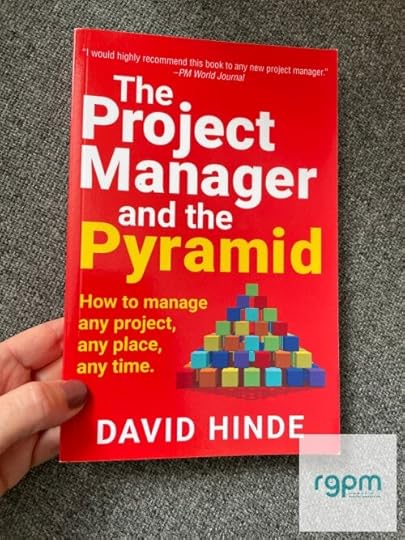 Retrospective Antipatterns
Retrospective AntipatternsAuthor: Aino Vonge Corry. PDU claim: 3 hours, although you can dip in and out as you need.
Retrospective Antipatterns is a great book for those in agile project management – especially if you’ve read all the classics. It looks at 24 reasons why retrospectives fail and what you can do differently to ensure your retros are worthwhile.
Full of stories and tips, this is one you’ll want to return to again and again.
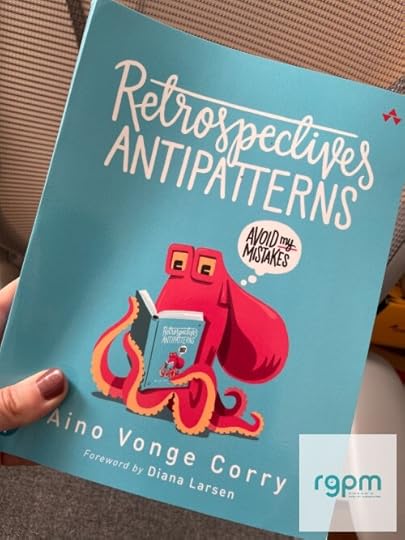 Identifying and Managing Project Risk (4th Ed)
Identifying and Managing Project Risk (4th Ed)Author: Tom Kendrick. PDU claim: 8 hours.
Identifying and Managing Project Risk is a big read at over 300 pages. There are some sections in it that cover enterprise risk management which you could justifiably claim in the Business Acumen section.
The book really does take you end-to-end through everything you need to do to spot and act on scope, schedule, resource risks and more.
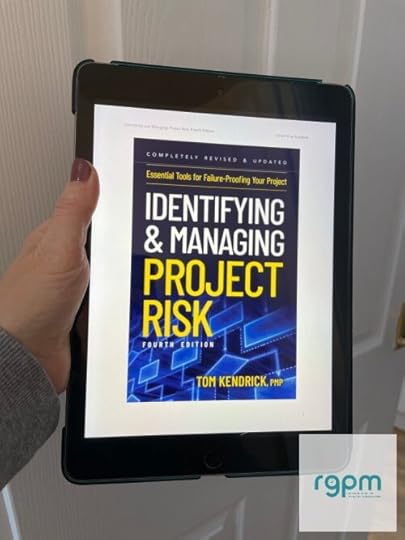 Making Risk Management Work (2nd Ed)
Making Risk Management Work (2nd Ed)Authors: Ruth Murray-Webster and Penny Pullan. PDU claim: 2 hours.
Making Risk Management Work is a slim read but it’s full of tips for how to run effective risk management workshops. And more than that: getting people to own and manage risk instead of it landing at the feet of the project manager (you) to do instead!
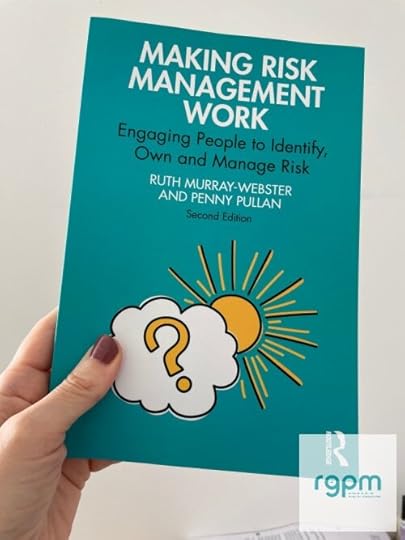 Managing Multiple Projects
Managing Multiple ProjectsAuthor: Elizabeth Harrin (yes, that’s me!). PDU claim: 5 hours.
Sorry, I felt like I had to include Managing Multiple Projects because it really will change the way you work, and that’s what the Ways of Working category is all about. Plus it comes with downloadable templates and loads of tips and tricks – not just from my experience but also from your peers.
If you are struggling to juggle your workload, this is the book to reach for first.
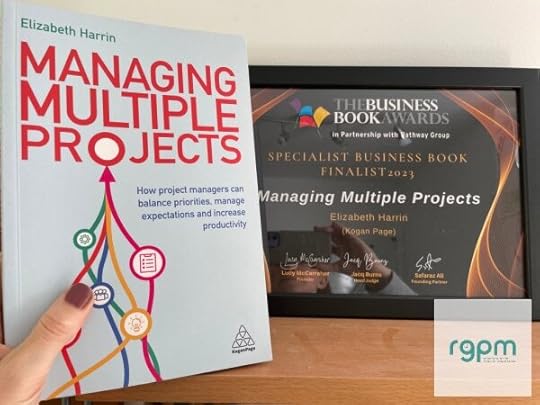 Power Skills Books
Power Skills BooksI love this category (which used to be Leadership) because it covers so much to do with teamwork, stakeholder engagement and all the interpersonal skills, which means you can justify so many books in it!
So many books fit into the Power Skills category of helping you improve your project management skills, so don’t be limited to only those aimed purely at project managers.
Project Management for HumansAuthor: Brett Harned. PDU claim: 2 hours
Project Management for Humans is a skinny book, but it’s packed full of tips for how to help people get things done. It focuses on the team aspects of project management, which is probably why I enjoyed it so much. Highly recommended!
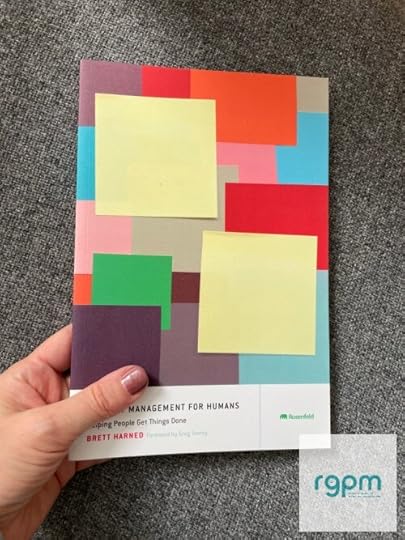 Be a Project Motivator
Be a Project MotivatorAuthor: Ruth Pearce. PDU claim: 4 hours.
Be a Project Motivator is perfect for people wanting to improve their team skills and create a culture of appreciation within their project team. It will teach you how to influence others, even when you are not directly managing them.
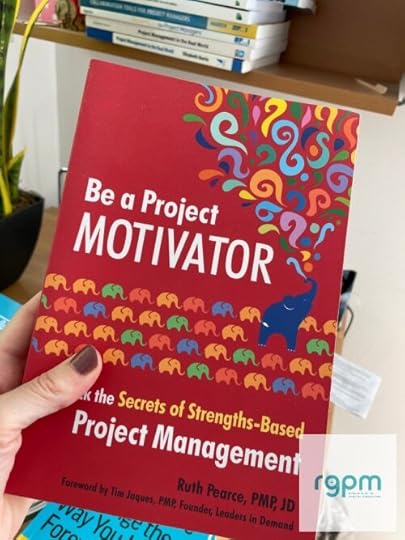 The Coaching Habit
The Coaching HabitAuthor: Michael Bungay Stanier. PDU claim: 2 hours.
The Coaching Habit is a short read, but I found it amazingly helpful in supporting colleagues and in my mentoring practice. I can’t say that I do a lot of ‘true’ coaching, but simply being able to ask the right questions (and the book tells you what they are) changes the way we have conversations. Great!
 Engaging Stakeholders on Projects
Engaging Stakeholders on ProjectsAuthor: Elizabeth Harrin. PDU claim: 4 hours.
Engaging Stakeholders on Projects is another one of my books, but it definitely deserves its place in the list if I do say so myself!
I wrote it to answer the question: what does engagement mean, and how do I do it? Because we talk about stakeholder engagement as a buzzword and so often when I’m mentoring project managers, it’s clear that working with people is the area so many of us struggle with.
The book is published by APM (the cover in the photo is their old branding), but it’s relevant for PMI certifications too.
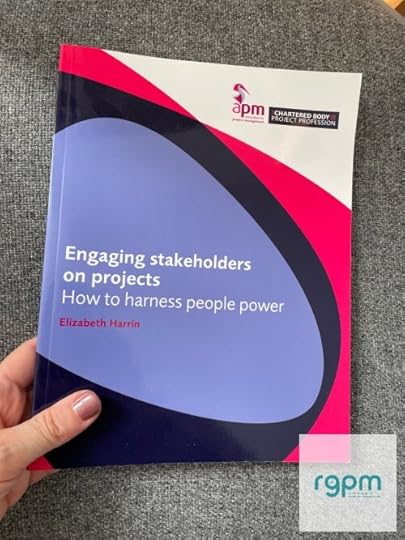 Emotional Intelligence for Project Managers (2nd Ed)
Emotional Intelligence for Project Managers (2nd Ed)Author: Anthony Mersino. PDU claim: 4 hours.
Emotional Intelligence for Project Managers is one of my all-time favorite reads, and one that totally reshaped how I looked at managing work and relationships at work when I was but a young project manager.
Definitely worth a read.
Business Acumen BooksBusiness Acumen used to be called Strategic and Business Management in the Talent Triangle, which I think is a clearer definition of what section of the library to look for! Any books about achieving business goals, portfolio management, strategy execution or case-study driven books will count here.
Business ResilienceAuthors: David Roberts, Islam Choudhury, Serhiy Kovela, Sheila Roberts, and Jawwad Tanvir. PDU claim: 9 hours.
Business Resilience is a longer read, but it’s a really interesting guide to how to make sustained progress at pace, whatever pace is appropriate to your organization. Basically, it’s about how not to be left behind.
Great for PMO leaders or those who want to shape the future of strategic delivery in their businesses, with lots of practical checklists and guidance.
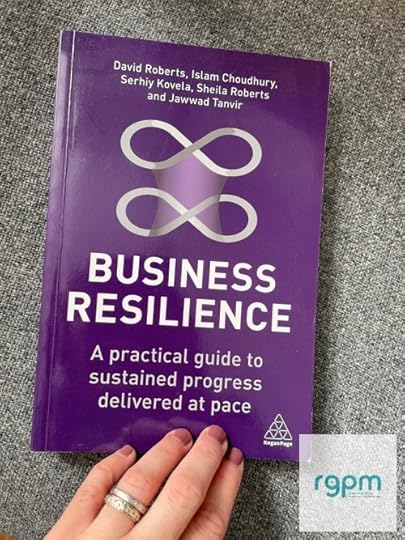 Driving Project, Program and Portfolio Success: The Sustainability Wheel
Driving Project, Program and Portfolio Success: The Sustainability WheelAuthors: Rich Maltzman and David Shirley. PDU claim: 5 hours.
Driving Project, Program, and Portfolio Success is all about creating a sustainable culture. It was first published in 2016, so that makes it quite old as books go, but sustainability is something that is taking more of a hold (thankfully) in how we deliver projects. Therefore, it’s worth diving into this subject as it helped me have conversations with colleagues about sustainable project execution.
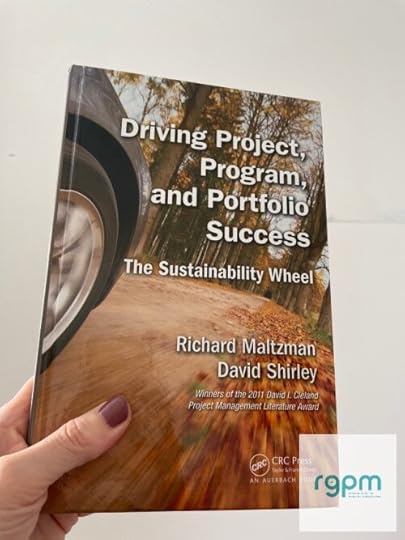 Good Charts
Good ChartsAuthor: Scott Berinato. PDU claim: 6 hours
Good Charts is the HBR Guide to Making Smarter, More Persuasive Data Visualizations. It’s not a ‘pure’ project management book, but it’s completely relevant as it covers how to report data. And projects have so many reporting and data requirements.
It’s fascinating to see how the history of data visualization has changed and how you can shape conversations and business outcomes by the choices you make. Great reading for anyone in a PMO role or who wants to make their dashboards and project reports more influential.
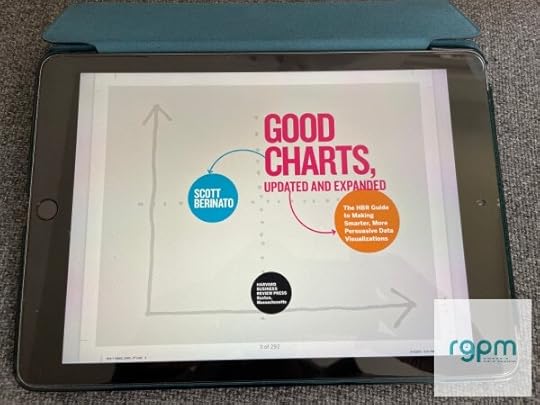 Harvard Business Review Project Management Handbook
Harvard Business Review Project Management HandbookAuthor: Antonio Nieto-Rodriguez. PDU claim: 10 hours.
HBR’s Project Management Handbook claims a place in the Business Acumen section because it’s not just about technical skills. The project canvas is a new way of thinking about how to launch, lead, and sponsor projects. It’s full of innovative approaches and project management principles that you’ll use over and over again.
I was impressed and took away some new techniques. There are some project management practices you’ll already be aware of, but there’s enough in here about how to deliver strategy to keep you turning the pages.
The Catalyst: How to change anyone’s mindAuthor: Jonah Berger. PDU claim: 6 hours.
The Catalyst was a riveting read, and I still remember some of the stories now. It’s about influence and negotiation and how to get things done. All skills we need in project delivery, especially when it comes to influencing strategy and decision-making.
Where to get the booksBuying business books is expensive. There are other options. For example:
Set up a business book corner at work and have people donate books or buy them from office funds for everyone to share.
Get books from the library. My library doesn’t have a great business book selection, but they will order books in and they can get almost anything for a 50p reservation fee.
Get the audiobook. If you have an Audible account, you can choose a business book every month. Or set up an Audible account and download your first book free.
Get the ebook. Often print books are way more expensive than digital books. While I like a paper copy, I have moved to ebooks for some books over the years because it is easier and cheaper, and I can carry more around with me. Kindle Unlimited will give you access to loads of books and is the easiest way I know of to get free project management books to earn PDUs, although check what’s available to you in your location.
Next stepsHopefully, that’s enough reading material to get you started! With these book recommendations for PMP PDUs, you’ll have plenty of options to earn what you need for recertification.
Check out other easy ways to earn PDUs for more tips on how to collect your hours.
This article first appeared at Rebel's Guide to Project Management
September 24, 2023
How to manage project tolerances (with PRINCE2® 7 guide)
Tolerances are an important part of being able to work autonomously as a project manager. You need to have the authority and freedom of action to be able to change the direction the work is going in.
However, the project sponsor is the person responsible for decisions that affect the project budget and the schedule, where making a change would deviate from the agreed plan.
So how do you balance your need to make small changes on a regular basis and the sponsor’s role of being the ultimate decision-maker about changes?
The answer is that you don’t.
Welcome to the wonderful world of project tolerances.
What is a project tolerance?A tolerance is a performance range you will keep to. The project tolerance definition I use in my book, Project Manager, is this:
Tolerances are how much you can flex within your project without having to go back for approval.
A project tolerance provides a boundary for the area of the project in which you can make changes without having to ask your sponsor’s approval.
They define your zone of responsibility. Essentially, the sponsor delegates authority to you to make small changes within a range of impact. You can change the dates or the budget as long as you don’t go outside the zone.
Having a tolerance means you can be over a bit or under a bit and not have to continually go back to your project sponsor and get any variation approved.
It gives you some slack to manage things in the best possible way and to be a professional about how you deliver projects.
Which level of management sets the project tolerances?Tolerances can (and often should) be set for the project, for a stage and also at work package level, so they can become very detailed.
The overall project tolerances should be agreed with the sponsor at the start of the project, so you know what parameters you are working to.
They form part of the “contract” you have with the sponsor – and getting this clear up front will make managing the project (and the sponsor) a lot easier as the project gets going.
How are tolerances set?Talk to your sponsor. Discuss how much wiggle room you think is appropriate. A good starting point is +/-10% of the already-agreed timescales.
They might want to set a lower figure for budget tolerances: project sponsors in my experience aren’t keen to go 10% over budget and not know about it.
What kinds of tolerance are there on a project?Positive tolerances (the amount by which you can go over) are the most common.
A positive tolerance is expressed as a positive percentage. It reflects how much more time/money/etc you can incur without having to ask permission to do so.
Negative tolerances are less common, but you can still use them. I think the general feeling is who cares if you are significantly under against budget or come in three months early?
Actually, negative tolerances are just as important. Coming in under budget means you have tied up company funds unnecessarily for a length of time, and in the current economic climate no sponsor will thank you for that.
That isn’t to say that you should spend company money on random items just to stay within tolerance, but once you drop below your tolerance levels it would be a good time to re-forecast your project budget and free up any spare cash that you won’t be using.
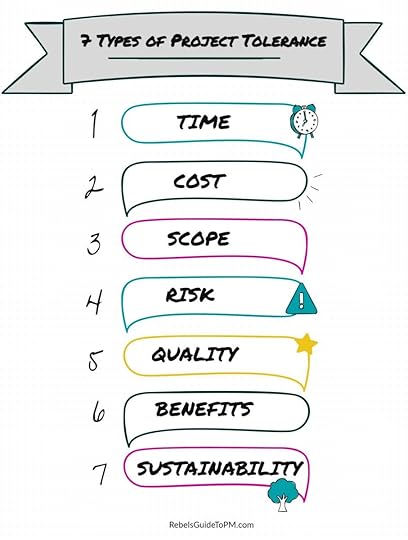 The 7 tolerances in PRINCE2®
The 7 tolerances in PRINCE2®The two most frequently used tolerances are budget and time, although PRINCE2® offers you a choice of seven tolerances: time, cost, scope, risk, quality, sustainability and benefits.
Let’s look at those individually.
Tolerance areaDescriptionTime+/- time of planned completionCost+/- amount of planned budgetScopePermitted scope variationsRiskPermitted aggregate threat value/individual threat valueQualityPermitted quality variations within a rangeBenefitsPermitted benefit variations within a rangeSustainabilityPermitted sustainability target variations withing a rangeTypes of tolerance in PRINCE2Time/Schedule toleranceA time tolerance is the amount to which you can be over or under against your project schedule dates.
For example, if the tolerance is 2 weeks you can deliver 2 weeks earlier or 2 weeks later without it having an impact. If you are too early you will have created a problem for another project; too late and you have missed the final deadline.
Cost toleranceCost tolerances are applied as either a percentage or a cash amount against the planned budget.
For example, on a £100k project with a 10% tolerance, you can spend up to £110k before having to ask for approval for more spend.
Scope toleranceScope tolerance is slightly odd, because it is a lot harder to quantify a percent variation to scope.
Scope tolerance is measured as an agreed variation from the product description, and any potential variation should be documented in the product breakdown structure.
Think priority listing for scope tolerance. MoSCoW prioritization will give you a list that provides potential for variation in delivery.
Risk toleranceEach risk should have an impact attached to it, and risk tolerance in project management covers the aggregate impact of the project’s risk portfolio.
For example, let’s say the financial value of all the project risks should not exceed 5% of the project budget. You can track that and at the point that the financial value of risks is going to exceed 5% you’ll know to escalate the issue. Perhaps the project needs to be taking a less risky approach.
You can also set a tolerance per risk, like “only two days of downtime permitted for any operational service”. Risk tolerances give you an idea of which risks you should be escalating to the Project Board.
Quality ToleranceQuality tolerances are targets that define acceptable quality criteria and performance for a product, and are documented in the product descriptions.
An example would be that a software product must have a response time of between 0 and 0.5 seconds when a user hits “Submit”. You would document these tolerance levels in the quality plan.
Benefits toleranceIt’s hard to think of a scenario where you would want to cap the project benefits, so in my experience, this type of tolerance is rarely discussed or used at the positive end of the scale.
You probably will find it useful to have a conversation about how much of the benefit you can lose before the project becomes unfeasible.
Benefit tolerances are defined as a range and will be part of the project’s business case. For example: “Achieve minimum savings on the cost of electricity of 6% for each of our shops, averaging 8% across all shops”. You would document that in a benefits management template.
Sustainability toleranceSustainability tolerances are new for 2023 in PRINCE2 7. They reflect the permissible deviation in performance targets that can happen before you have to escalate to the next level.
Let’s say a project had a sustainability target of reducing carbon for a particular process by 17%. The tolerance could be 15-20%. If the project was on track to perform outside of that range, the project team would escalate to the next level of management (probably the project board) and let them know.
Key takeawaysHave a conversation with your project sponsor during the Project Initiation phase so you know what your acceptable freedom of action zone is.Document the tolerances agreed so you have a record.Track and monitor project performance against those tolerances so you can escalate when the project looks like it will go out of tolerance for any reason.Pin for later reading:
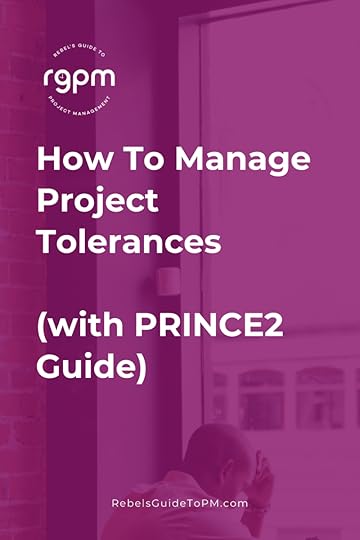
This article first appeared at Rebel's Guide to Project Management
How To Close A Project In PRINCE2
This article has been updated to be fully aligned to PRINCE2 7 (2023 edition).
A project has a start, a middle and an end, so closing a project is an important part of the project management lifecycle.
Closing a project successfully means a good, clean transition for the project team. This involves transferring ownership of the products to the operational team, and makes it clear that the project team are no longer responsible for them.
The project manager and the team will be able to move on to their next assignment.
A clear end to the project also provides an opportunity to ensure that any goals that were not achieved during the project can be addressed in the future.
How does PRINCE2® handle closing a project?Closing a project in PRINCE2® uses a variant of the Managing a Stage Boundary process, as this closure activity happens at the end of the last stage. The work required to close the project should be planned as part of this final stage. You also use this process if the project closes prematurely.
The Closing a Project process tackles the end of the current stage in a slightly different way to the other stages: instead of gaining approval to move to the next stage, this process gains approval to close the project and handover to operations instead.
 What are the objectives of the Closing a Project process?
What are the objectives of the Closing a Project process?The objectives of the Closing a Project process are:
To verify that there is user acceptance of the project’s productsTo ensure that the operational team is able to support the products when the project is closedTo review project performance against the baselines that were setTo assess any benefits that have already been realized, update the forecast for the remaining benefits and plan a review of those benefits at some point in the futureTo ensure that provision has been made to address all the open issues and risks, with follow-on actions or recommendations.And of course to ensure the project is closed down in a structured and professional way, and not dropped like a hot potato while everyone runs on to the next shiny thing.
How do I close down a project?There are four areas to cover when closing a project. Let’s take a look at those, and you’ll see that they are pretty much common sense.
1. Prepare the closureWhether your project is facing a premature close or as part of the natural plan for the work, you have to prepare the closing stage.
If necessary, present a closure recommendation to the board, although the likelihood is they will already know that closure is on the cards.
Still, you have to tell people the project is closing, draft a closure notification for the project board to review, archive anything that needs arching and tidy up your records in your project management tool. Close out anything outstanding in the risk register as well.
2. Confirm project acceptanceNext, the project’s products must be handed over to the operational team. This could be done in one go, or it might have happened as part of a phased delivery.
If anything is not yet completed, prepare a follow-on action list or recommendations for the operational team to pick up, including scheduling a review of benefits at a later date.
Handovers don’t have to be one-and-done. You could have handed over deliverables at the end of every stage, so if that’s the case, just tie up any loose ends at this point.
Check that the benefits management approach is updated and that there is a plan to measure and track any benefits that will be delivered after project close.
3. Evaluate the projectThis provides the opportunity to review the project’s original intent as agreed back in the initiation stage, against what was actually accomplished. Look at the objectives, key success criteria, goals, acceptance criteria, KPIs and anything else that was determined at the beginning, and do a comparison to see how close you were to achieving those.
The evaluation can be presented as an End Project Report, which covers how the project performed against targets, tolerances and the baseline schedule. The evaluation can also include a Lessons Learned Report, so that future projects can learn from what went well and what didn’t go so well on this project.
PRINCE2® Practitioner, Online Course and Exam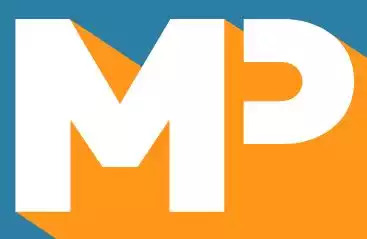 £659
£659 A comprehensive and accredited PRINCE2® Practitioner online course, including exam voucher and simulator access.
Buy NowWe earn a commission if you click this link and make a purchase, at no additional cost to you #ad
PRINCE2® Foundation Exam Simulator £64
£64 A confidence-boosting set of mock exam questions to prepare you for the PRINCE2® Foundation exam in realistic test conditions
Buy NowWe earn a commission if you click this link and make a purchase, at no additional cost to you #ad
PRINCE2® Practitioner Exam Simulator £94
£94 A robust and realistic exam simulator for PRINCE2® Practitioner with 4 full exams.
Buy NowWe earn a commission if you click this link and make a purchase, at no additional cost to you #ad
What if the project is closing before it completes?Planned closure isn’t the only way that projects end.
Projects sometimes need to be stopped before they are planned to finish. There are many reasons for this, including that the business environment or strategy may have changed, negating the need for the project. Maybe the project isn’t viable any longer. Maybe the key stakeholder pushing for the project has left and everyone is relieved they can finally drop it.
Regardless of the situation, the project can still be closed in a controlled manner. Following a structure and not simply abandoning the project lets the project manager salvage anything of value and check that senior management is aware of any gaps left by cancelling the project.
When a project is closed prematurely, there may be some products that have been completed. These can be handed over to the operational team if appropriate.
It is also useful to notify the management teams that the project team will be released early and the team members will be available to take on other assignments.
When a project is stopped early, it is really important to make sure that there is adequate communication to the business and the project team.
People don’t like to be associated with failed projects, so try to communicate the positive aspects of what the project managed to achieve before it was stopped, and clearly explain the business rationale for stopping the project at this time.
Where can I get more guidance?Chapter 19 is the PRINCE2® 7 manual reference that you need. If you did a training course, you can also refer back to your notes there.
Your next stepsRead more on how to close a project.Get a project closure template from your PMO and start looking at what is required to fill it in.Talk to your team about the products that need handing over and make plans to do that as the first step to shutting down the project.This article first appeared at Rebel's Guide to Project Management



